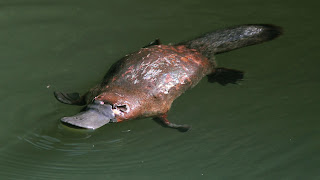Week 6: Bio Tech + Art
Biotech Art is the first topic in this course that I do not entirely believe in or have my complete faith in. According to the Science Daily Biotech Art "ranges from bacterial manipulation to glowing rabbits, and cellular sculptures" (2015). This can also extend into the creation of GMOs, experimentation of animals, and the creation of hybrid species according to professor Vesna (2019). Biotech art can have its positives and negatives, but in this blog, we will be taking a look at a few examples of biotech art and analyzing them within the context of this class.
When you think of marvels in our world or natural creations that we would imagine being part of a cartoon or artists imagination, which animals or organisms do you think of? I personally think of the platypus, an animal that is an otter, a beaver, and a duck in many unique ways. According to national geographic, even the scientists who were first studying the animals were under the impression that it was all a joke or a prank. Another one of those marvelous creations within our ecosystem that came about naturally is the slime mold (Levy). The slime mold is in many ways like the platypus, it is a fungus, animal. and plant all at the same time. I choose to believe that these species or creations of nature are natures way of inspiring the artistic spirit in humans.
When conducting my research on BioTech Art I came across a very interesting art installation by Oron Catts and Ionat Zurr and Australian art duo that created an art piece out of living mouse tissue and named it the "victimless leather", according to weird science (2013). Although I found this to be very interesting, I did find it a bit unsettling and worrisome. I believe that biotech art should be allowed but under proper regulations and standards. I am fearful that eventually, the art will end up grossing moral and ethical lines that will eventually arise as this expands and grows more.
I ultimately support BioTech art and believe that it is a positive step in the right direction both for science and arts expansion and growth. According to the outlaw symposium essay, outlaw biology is having the ability to freely express and create or practice biology by oneself. I believe that this mindset is excellent moving forward and that bio art can be a fantastic advancement and integral part of society but we need to be careful how far we go and where we draw the lines.
Work Cited
When you think of marvels in our world or natural creations that we would imagine being part of a cartoon or artists imagination, which animals or organisms do you think of? I personally think of the platypus, an animal that is an otter, a beaver, and a duck in many unique ways. According to national geographic, even the scientists who were first studying the animals were under the impression that it was all a joke or a prank. Another one of those marvelous creations within our ecosystem that came about naturally is the slime mold (Levy). The slime mold is in many ways like the platypus, it is a fungus, animal. and plant all at the same time. I choose to believe that these species or creations of nature are natures way of inspiring the artistic spirit in humans.
When conducting my research on BioTech Art I came across a very interesting art installation by Oron Catts and Ionat Zurr and Australian art duo that created an art piece out of living mouse tissue and named it the "victimless leather", according to weird science (2013). Although I found this to be very interesting, I did find it a bit unsettling and worrisome. I believe that biotech art should be allowed but under proper regulations and standards. I am fearful that eventually, the art will end up grossing moral and ethical lines that will eventually arise as this expands and grows more.
I ultimately support BioTech art and believe that it is a positive step in the right direction both for science and arts expansion and growth. According to the outlaw symposium essay, outlaw biology is having the ability to freely express and create or practice biology by oneself. I believe that this mindset is excellent moving forward and that bio art can be a fantastic advancement and integral part of society but we need to be careful how far we go and where we draw the lines.
Work Cited
Miranda, C. A. "Weird Science: Biotechnology as Art Form". Art News. 2013.
Bioart: An Introduction. November 23. 2015. Cell Press, Science Daily.
Meanings of Participation: Outlaw Biology? Outlaws, Hackers, Victorian Gentlemen. Outlaw Symposium Essay.
Ellen K. Levy. Defining Life: Artists Challenge Conventional Classifications.
Nat Geo Article
Vesna, V. Lecture. 2019. UCLA.






Comments
Post a Comment